Quantificatio of phenolic compounds and antioxidant capacity of an underutilized Indian fruit:Rayan[Manilkara hexandra(Roxb.)Dubard]
Bhumi Parikh,V.H.Patel
Laboratory of Foods and Nutrition,P.G.Department of Home Science,Sardar Patel University,Vallabh Vidyanagar,388120 Gujarat,India
Abstract The fruit of Manilkara hexandra (Roxb.) Dubard is one of the most underutilized fruits of India and in Gujarat state.It is popularly known as‘Rayan’.The fruit and seed of Rayan were analysed for their total phenolic and flvonoid content,phenolic compounds and total antioxidant capacity with six different assay methods.The results indicated that the methanolic extract of Rayan fruit being a good source of phenolic(811.3 mg GAE/100 g fw)and flvonoid(485.56 mg RE/100 g fw)content.Also,eleven known phenolic compounds were tentatively identifie for the firs time from the fruit and seed of Rayan.The LC–MS/MS analysis of fruit revealed the presence of major phenolic compounds such as gallic acid,quercetin and kaempferol,while quercetin,gallic acid and vanillic acid in seed.The presence of quercetin suggests health benefits The fruit of Rayan was also proved to be a better source of antioxidants as measured by FRAP,RPA,DPPHRSA,ABTSRSA and HRSA except NORSA in comparison with that of seed.The current study explains that M.hexandra is a relatively good source of antioxidants such as phenols and flvonoids for diet.
Keywords:Manilkara hexandra (Roxb.) Dubard; Underutilized fruit; High performance liquid chromatography–mass spectrometry; Phenolic compounds; Total antioxidant capacity
1.Introduction
Evidence is increasing regarding a range of a diet-chronic disease link.Thus,nutrition research has shifted from focusing exclusively on alleviating nutrient deficiencie to prevent or reduce morbidity and mortality due to chronic diseases[1,2].Alongwiththedailydiet,increasedfruitandvegetableconsumption has been promoted and correlated immensely not only for their nutritional content but also for their potential health functionality against various degenerative diseases such as cancer,cardiovascular,cataract,diabetes,and neurodegenerative diseases like Alzheimer’s and Parkinson’s [3].This phenomenon has been attributed to the protective effects of antioxidant components contained in fruit,which are a rich source of natural enzymatic and non-enzymatic antioxidants [4].In addition to the traditional nutrient antioxidants (e.g.,vitamins C and E and β-carotene),fruits contain polyphenolic (e.g.flvonoids)compounds,which may play an important role in the overall antioxidant activity of fruits[5].
Manilkara hexandra(Roxb.)Dubard[Synonym:Mimusops hexandra(Roxb.)]belongs to Sapotaceae family.It is a socioeconomicallyimportantunderutilizedfruitspeciescharacterized by the presence of sticky,usually white latex in the cuts of bark,branches,leaves and fruit.The small to medium sized evergreen trees are mostly found in western and central Indian states of Rajasthan,Gujarat,Madhya Pradesh and Maharastra [6].The matured fresh fruits are obovoid-oblong to ellipsoid in shape,measuring about 1–1.5 cm wide (Fig.1),one or two seeded,shining yellow colored which is soft and sweet in taste,being a good source of minerals and vitamins with low fat content[7,8].It is locally known as‘Rayan’or‘Khirni’.The fruit and other parts of the tree (bark,stem bark,root,leaves and latex)are known for their various nutritional and medicinal properties used by the older and tribal peoples of India.It has been shown that,this fruit is nutritionally necessary for a well-balanced diet as the methanolic extract of fruits are reported to have significan hypoglycemiceffectandcanbeuseinthemanagementorcontrol of type II diabetes [9].In addition,the acetone fraction ofM.hexandraseed is reported to contain the crude saponin mixture with significan anti-inflammator activity[10].The seeds ofM.hexandracontain approximately 25%edible oil,which can be usedforcookingpurposes[11].Itisknowntohavehighremedial value as it is demulcent and emollient [12].Parikh et al.[13]studied the nutritional profil of an underutilized Indian fruit of Rayan.
Despite very few literatures showed the importance and medicinal use of various parts of Rayan tree,it still represents the lack of data regarding identificatio of phenolic compounds and antioxidant capacity.In this context,the present study was planned for the identificatio of phenolic compounds,total phenolic content,flvonoid content and total antioxidant capacity using various assay methods from fruit and seed of Rayan.
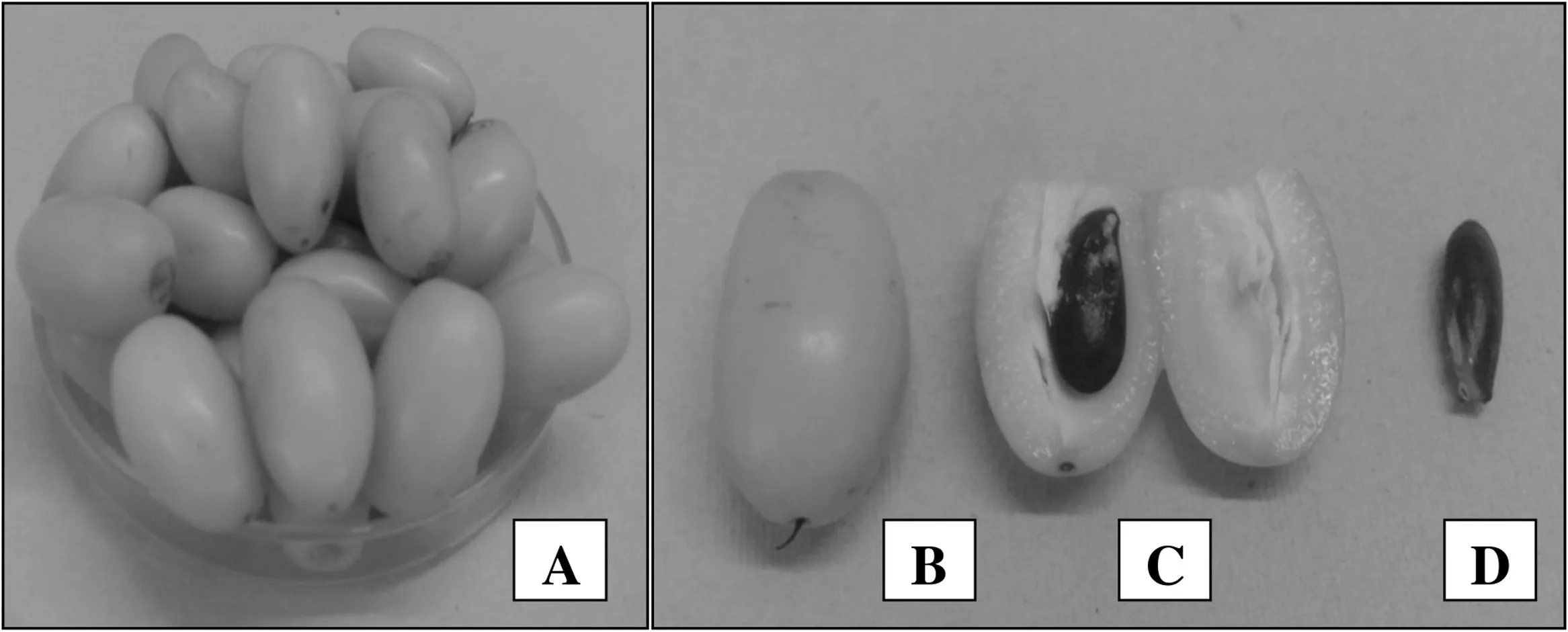
Fig.1.Whole fruits of Rayan[Manilkara hexandra(Roxb.)Dubard](A),single fruit(B),section(C)and seed(D).
2.Materials and methods
2.1.Chemicals
ABTS (A 1888),L-ascorbic acid (95210),DPPH (D 9132),gallic acid (G 7384),N-(1-naphthyl ethylenediamine dihydrochloride)(N 9125),1,10-phenanthroline(320056),rutin hydrate (R 5143),sulphanilamide (33626),TPTZ (T 1253)were of Sigma–Aldrich brand,while sodium nitroprusside(dihydrate) (71778) and Trolox (56510) were of Fluka brand(Sigma–Aldrich,Bangalore,India).Other chemicals used were of analytical grade.The solvents used for chromatography were of HPLC grade.
2.2.Sample
2.2.1.Sample preparation
ThefruitsofRayan(M.hexandra)(onekilogramoffresh,ripe but fir fruits,free from bruises)were purchased from the local market of Anand(Gujarat,India).They were thoroughly washed under running tap water,cut in halves,deseeded to get the edible part and crushed in a mixer.Its freshly collected seeds were also washed,oven dried and powdered using a kitchen grinder.
2.2.2.Sample extraction for phenolic content and antioxidant determination
The fruit pulp and seed powder of Rayan were used for the extraction for the determination of phenolic content and antioxidant.The 5.0 g and 2.0 g of fruit and seed samples respectively were extracted thrice in 80% aqueous methanol (pH 2.0) by shaking at room temperature for 90 min.Supernatants were centrifuged,filtere and the volume of each of these samples was made up to 50 ml with the solvent using a volumetric flask The extracts were stored at −20◦C for the estimation of total phenolic content and total antioxidant capacity.The fruit and seed samples were extracted in duplicate batches with two separate purchases in the same season and four observations of two different experiments were analyzed statistically.
2.3.Determination of total phenol
2.3.1.Total phenolic content
Total phenolic content was determined using Folin–Ciocalteu method[14].Gallic acid was used as a standard and the results are expressed in milligrams of gallic acid equivalent per 100 g sample(mg GAE/100 g).

Table1 Total phenolic and flvonoid content of fruit and seed of Rayan.
2.3.2.Flavonoid content
Concentrated methanolic extracts was used for the estimation of flvonoid and the absorbance was read at 510 nm [15].Comparison was done using the rutin as standard and the results are expressed as mg of rutin equivalent per 100 g sample (mg RE/100 g).
2.4.Phenolic compound composition by LC–MS/MS analyses
2.4.1.Sample preparation
The fruit(1.0±0.29 g fw)and seed(1.0±0.04 g dw)samples of Rayan were pulverized separately using ceramic mortar pestle with the addition of methanol and volume was made up to 10 mL.These samples were then filtere through 0.2 μm nylon membrane syringe filte and three replicates of each sample were extracted and injected separately to minimise the error.
2.4.2.Quantification of polyphenols
In the present study,11 known polyphenols (Table2) were analyzed from fruit and seed sample.The UPLC was carried out to identify phenolic acids and flvonoid compounds on a Waters Acquity SDS system(Waters,MA,USA)equipped with a binary solvent delivery pump,an autosampler and photodiode array(PDA)detector.A Waters Acquity UPLC®BEH C18 column (100×2.1 mm i.d.; 1.7 μm) was used.The mobile phase consisted of methanol(solvent A)and 1%of methanol in water(solvent B) at a f ow rate of 0.4 ml/min.The gradient elution was performed as follows:5% of A and 95% of B solvents was f xed initially,then increased solvent A to 20%in 0–1 min,35%in 1–3 min,50%in 3–5 min,75%in 5–6 min,isocratic at 75%solvent A in 6–8 min,returned to 50%in 8–10 min,15%in 10–12 min,5%in 12–14 min and a reequilibration period of 1 min with 5%solvent A used.Needle was washed with weak and strong solvents to avoid the cross contamination and analytical error during analysis.The injection volume was 10 μl,column temperature was set at 35◦C in column heater and sample manager was maintained at 4◦C.The PDA detection wavelengths were set at 190 nm–400 nm.
The fragmentation was done in electrospray ionisation mass spectrometry (ESI-MS/MS) in negative ionization mode with different fragmentor voltage and collision energy (Table2),using 99% pure nitrogen in desolvation gas with flw rate of 700 L/h.Second stage tandem-MS profile were obtained by collision induced dissociation-mass spectrometry (CID-MS),using 99% pure argon as collision gas with the flw rate of 20 L/h.Continuous full mass spectral data were obtained by scanning fromm/z50 to 700.Data were processed with Mass Lynx 4.1 software (Waters,MA,USA).Identificatio of the phenolic compounds present in the sample was achieved by comparison with retention times and spectra with those of standard compounds(Sigma–Aldrich Company)based on external standard method by employing calibration curves in the range of 0.01–1.0 μg/mL.Results were expressed as μg/100 g of sample.
2.5.Determination of total antioxidant capacity
2.5.1.Ferric reducing antioxidant power
The ferric reducing antioxidant power(FRAP)assay was carried out by following the method of Benzie and Strain[16].The water-soluble vitamin E analog Trolox standard was used for the comparison and results are expressed in terms of mg Trolox Equivalent per 100 g sample(mg TE/100 g).
2.5.2.Reducing power assay
This assay was performed using the method described by Oyaizu[17].Different aliquots of Trolox were treated as standard and results are expressed in terms of mg TE per 100 g sample.
2.5.3.DPPH radical scavenging activity
The method proposed by Brand-Williams et al.[18]was followed for determining the antioxidant activity of the methanolic extract of fruit and seed of Rayan,on the basis of the scavenging activity of the stable 2,2-diphenyl-1-picrylhydrazyl(DPPH)free radicals.Percentage inhibition was calculated and results are expressed as mg TE per 100 g sample.
2.5.4.ABTS radical scavenging activity
The ABTS [2,2′-azino-bis (3-ethyl benzothiazoline-6-sulfonic acid) diammonium salt]radical scavenging activity assay was carried out using the modifie autobleaching method[19].The percentage inhibition was calculated and the results are expressed as mg TE/100 g of sample.
2.5.5.Nitric oxide radical scavenging activity
Nitric oxide was generated from sodium nitroprusside and measured by Greiss reaction[20].Percentage nitric oxide radical scavenging activity(NORSA)was calculated.Different aliquots ofL-ascorbic acid were treated as standard.The results are expressed in terms of mgL-ascorbic acid equivalent per 100 g of sample(mg AAE/100 g).
2.5.6.Hydroxyl radical scavenging activity
The hydroxyl radical scavenging activity(HRSA)was determined using the modifie method as suggested by Jin et al.[21].In this system,hydroxyl radicals were generated by the Fenton reaction.The reaction mixture without any antioxidant was used as the negative control,and without H2O2was used as the blank.The percentage HRSA was calculated.The results areexpressed in mgL-ascorbic acid equivalent per 100 g of sample(mg AAE/100 g).
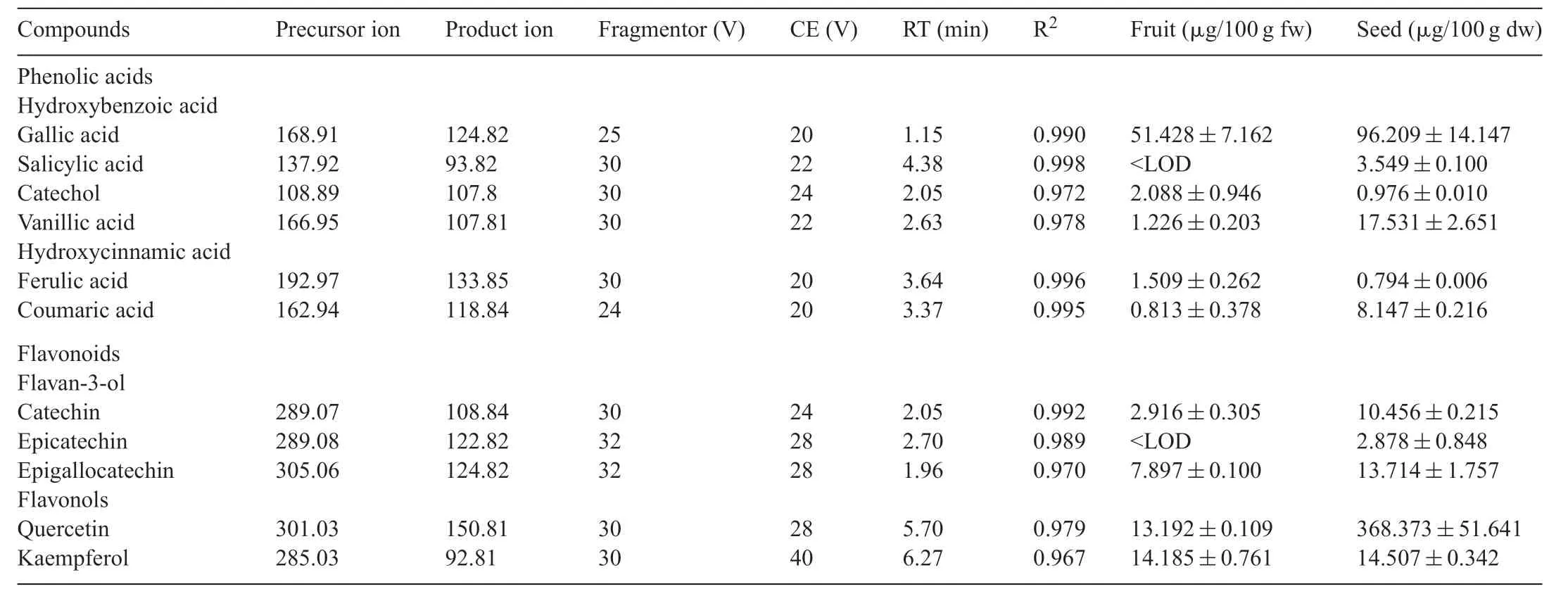
Table2 Phenolic compounds identifie from fruit and seed of Rayan by LC–MS/MS.
2.6.Statistical analysis
The experimental results are expressed as mean±standard deviation(SD).Afterwards,the results were subjected to analysis of variance(ANOVA),the significanc of mean differences was determined by Duncans’post hoctest consideringp<0.05 significan level of difference.All the statistical calculations were done using SPSS version 20.0.
3.Results and discussion
3.1.Total phenolic and flavonoid contents in fruit and seed of Rayan
Total phenolic and flvonoid content was found significantl higher (p<0.05) in Rayan fruit than that of seed (Table1).In the methanolic extract of fruit,total phenolic and flvonoid content was found to be 811.3 mg GAE/100 g fw and 485.56 mg RE/100 g fw,respectively.Patel and Ramana Rao [22]estimated total phenolic content at different maturity levels in the Khirni fruit and found to be 126 mg/100 g at its young stage,and eventually,the level of phenols in the ripened fruit increases significantl (428 mg/100 g).Patel and Ramana Rao[22]attributed thereasonsforthiskindofincreaseinphenoliccontentasthatthe biosynthetic mechanism of certain phenolic compounds appears tobereceptivetoenvironmentalstimuliandcertainphenolicsare suspected of being implicated in some types of stress responses.Approximately 50%higher total phenolic content was found in the present study.
Total phenolic content of seed was found to be 190.19 mg GAE/100 g dw while flvonoid content was found to be 117.78 mg RE/100 g dw.The total phenolic and flvonoid content ofManilkara zapotaseed was analyzed by Shanmugpriya etal.[23]usingfourdifferentsolventsandfound ranged between 121 to 400 mg GAE/100 g and 74 to 398 mg QE (Quercetin equivalent)/100 g respectively which supports the result of the present study.
3.2.Identification and quantification of phenolic compounds from fruit and seed of Rayan by LC–MS/MS
As known,polyphenols are among the most important and well-known bioactive compounds present in fruits naturally.The eleven known phenolic compounds were successfully separated and tentatively identifie for the firs time from this underutilized wholefruitofRayan.Analysisofphenoliccompoundsfromfruit and seed was performed using reversed-phase UPLC (Fig.2).The major groups of phenolic compounds quantifie were phenolic acids(hydroxybenzoic acids and hydroxycinnamic acids)and flvonoids using an external standard method (Table2).From our results,among all phenolic compounds,gallic acid was found to be the most predominant compound in fruit.Among phenolic acids,gallic acid,one of the hydroxybenzoic acids,was found to be highest in fruiti.e.51.428 μg/100 g followed by catechol(2.088 μg/100 g),ferulic acid(1.509 μg/100 g),vanillic acid (1.226 μg/100 g) and coumaric acid (0.813 μg/100 g fw).Salicylic acid was not detected in fruits.According to Manach et al.[24],gallic acid,among phenolic acids,is tremendously well absorbed into the human body,compared with other polyphenols.It was shown to have a positive effect against cancer cells underin vitroconditions[25].Fruits almost exclusively contain a range of flvonoid compounds including flvan-3-ol and flvonols.In the present study,the flvonoid compounds found in Rayan fruit in the order of kaempferol(14.185 μg/100 g fw) >quercetin (13.192 μg/100 g fw) >epigallocatechin (7.897 μg/100 g fw) >catechin (2.916 μg/100 g fw).Epicatechin was found below detection limit in fruit.The most promising characteristic is its quercetin content which is a polyphenol belonging to the flvonoid group found in a wide variety of fruits and vegetables.Anin vitrooxidation model showed quercetin,myricetin,and rutin being more powerful anti-oxidants than the traditional vitamins [26,27].Quercetin and catechins are also reported as peroxyl and hydroxyl freeradical scavengers and demonstrate protective effects against lipid peroxidation[28].Rastogi and Mehrotra[29]also isolated and characterized some important chemicals such as hexandrone,quercetin,quercitrin and hexandrin from the fruit of Khirni.Ma et al.[30]studied fractionation of a methanol extract from the fruit ofM.zapotacv.Tikal resulted in the isolation of two new antioxidants methyl 4-O-galloylchlorogenate,4-Ogalloylchlorogenic acid,along with eight known polyphenolic antioxidants,namely,methyl chlorogenate,dihydromyricetin,quercitrin,myricitrin,catechin,epicatechin,gallocatechin,gallic acid.
On the other hand,in the present study,LC–MS/MS quantificatio of the seeds of Rayan demonstrated highest content of quercetin among all phenolic compounds.Of all phenolic acids found presently,gallic acid was found to be high in seed with 96.209 μg/100 g extract followed by vanillic acid(17.531 μg/100 g),coumaric acid (8.147 μg/100 g),salicylic acid (3.549 μg/100 g),catechol (0.976 μg/100 g) and ferulic acid(0.794 μg/100 g)while regarding flvonoids,seed had the most dominant contents of quercetin(368.373 μg/100 g dw)followed by kaempferol (14.507 μg/100 g dw) >epigallocatechin(13.714 μg/100 g dw)>catechin(10.456 μg/100 g dw)>epicatechin(2.878 μg/100 g dw).Three phenolic compounds such as gallic acid,myrecetin and quercetin were isolated by Eskander et al.[10]through chromatographic separation of acetone precipitate of seeds ofM.hexandra.From our results,we concluded that Rayan fruit and seed may be used as a good source of dietary phenolic and flvonoid constituents.

Table3 Total antioxidant capacity of fruit and seed of Rayan.
3.3.Total antioxidant capacity(TAC)of fruit and seed of Rayan
There are different methods for the measurement of total antioxidant capacity(TAC)that involve the generation of radical species,where the presence of antioxidants determines the disappearance of radicals[31].Keeping in mind the efficien y of antioxidant study,it has been recommended to employ as a minimum threein vitromethods instead of relying on a single assay to assess and compare the antioxidant capacity owing to variability of values in free radical-scavenging assay systems[32].Thus,the estimation of TAC was carried out by six different assays from the fruit(fresh)and seeds(dried)of Rayan,an underutilized fruit of Sapotaceae family.Addition to this,this fruit also reported for its medicinal importance to cure several diseases by the tribal village peoples.Until now,to the best of our knowledge,there is no such report available to highlight the evaluation of TAC of this fruit.
3.3.1.FRAP and RPA assay
The FRAP and RPA assay are commonly used to study the antioxidant capacity of plant materials.FRAP method is based on the ability of the sample to reduce ferric to ferrous iron in the presence of TPTZ which may be attributed from hydrogen donation from phenolic compounds.Reducing power(RPA)of a compound may serve as a significan indicator of antioxidant activity which measures its capacity to reduce an oxidant by donating an electron and high reducing power indicates strong antioxidant activity[33].The results of TAC measured by FRAP and RPA values of fruit and seed are shown in Table3.The FRAP and RPA values were found significantl higher(p<0.05)in fruit as compared to its corresponding values in seed.The FRAP and RPA values of fruit were found to be 8287.50 mg TE/100 g fw and 3025.00 mg TE/100 g fw respectively.Jamuna et al.[34]found that methanolic extract ofM.zapotafruit with 8.2 μg AAE/mg of extract of RPA,whereas in the present study the seeds of Rayan had 803.13 mg TE/100 g dw and 545.31 mg TE/100 g dw values for FRAP and RPA respectively.M.zapotaseed was analyzed for its RPA by Shanmugpriya et al.[23]using four different solvents and found range from 09.41 to13.96 μg/mL of extract.
3.3.2.DPPH and ABTS radical scavenging activity
The free radical chain reaction is extensively acknowledged as a common mechanism oflipid peroxidation.Radical scavengers may directly react with and quench peroxide radicals to terminate the peroxidation chain reaction [35].DPPH is widely used for quickly assessing the ability of polyphenols to transport labile H atoms to radicals,a likely mechanism of antioxidant protection [36]where as the ABTS radical cation,generated by potassium persulfate,which scavenge aqueous phase radicals is used for determining the antioxidant activity.The DPPH and ABTS radical scavenging activity were found significantl (approximately 90%)higher(p<0.05)in fruit than that of the values found in seed(Table3).The methanolic extract of fruit sample had 1861.17 mg TE/100 g fw of TAC as measured by DPPH RSA.On the other hand,by using the ABTS decolourisation assay,we have measured the antioxidant capacity and found 697.14 mg TE/100 g fw in fruit sample.Reddy et al.[37]extractedM.zapotafruit in 60% methanol containing 0.1% HCl and showed 141 mg TE/100 g of DPPH RSA and 55 mg TE/100 g ABTS RSA.In the present study it was observed that TAC in seed had 189.68 mg TE/100 g dw of DPPH RSA and 61.77 mg TE/100 g dw of ABTS RSA.According to Eskander et al.[10]acetone and methanolic seed extracts ofM.hexandrawith DPPH assay had no antioxidant activity.
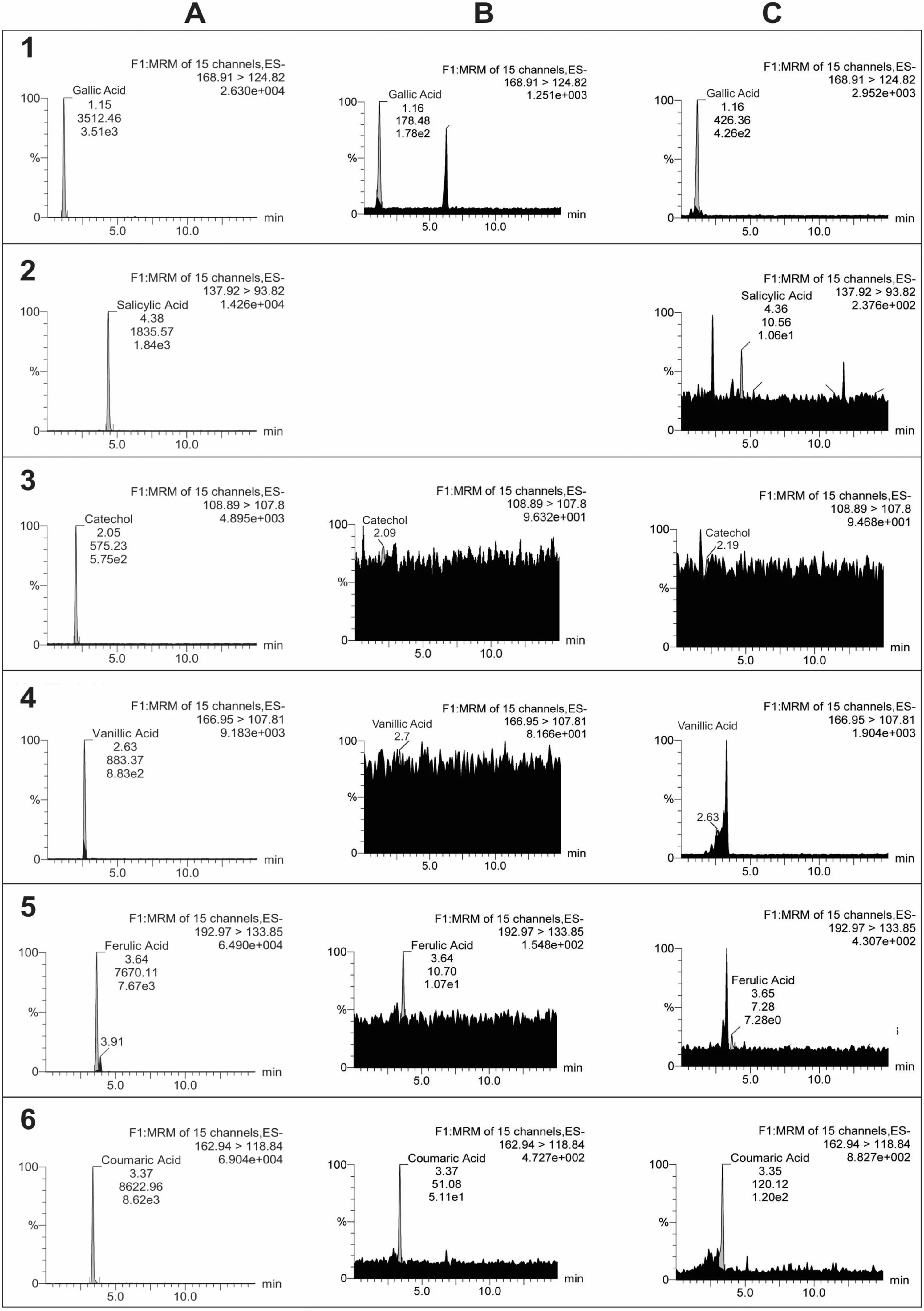
Fig.2.Chromatograms of phenolic standards(A),fruit(B)and seed(C)of Rayan by C18 RP-HPLC-ESI-MS/MS.1.Gallic acid,2.salicylic acid,3.catechol,4.vanillic acid,5.ferulic acid,6.coumaric acid,7.catechin,8.epicatechin,9.epigallocatechin,10.quercetin,11.kaempferol.
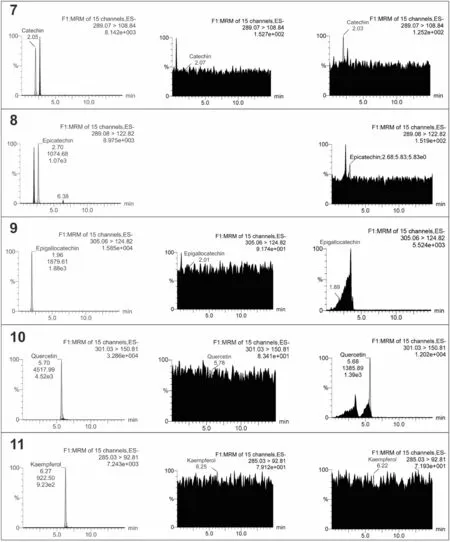
Fig.2.(Continued)
3.3.3.Nitric oxide radical scavenging activity
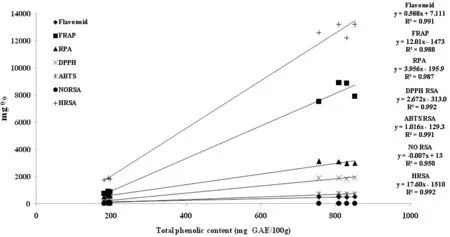
Fig.3.Correlation of total phenolic content with flvonoid and total antioxidant capacity by six different assays of fruit and seed of Rayan.ABTSRSA:ABTS radical scavenging activity;DPPHRSA:DPPH radical scavenging activity;FRAP:ferric reducing antioxidant power assay;HRSA,hydroxyl radical scavenging activity;NORSA,nitric oxide radical scavenging activity;RPA:reducing power assay;GAE,gallic acid equivalent.
Nitric oxide(NO)is an important intracellular and intercellular regulatory defense molecule with cytotoxic,microbiocidal andmicrobiostaticactivities.Invitro,sodiumnitropruside(SNP)will release nitric oxide and react with oxygen to form nitrite.SNP solution under aerobic conditions,in the presence of sample extract with Griess reagent,can be used to evaluate the nitric oxide scavenging activity[38].Interestingly,the lower antioxidant capacity measured by NORSA was found in fruit of Rayan(7.29 mgAAE/100 gfw)thanfoundinseed,whichhad11.67 mg AAE/100 g dw,showed significan difference(p<0.05)between the values(Table3).However,negative correlation was observed between total phenol and NORSA (Fig.3).The results of the present study are in agreement with the fact that other than total phenolics and flvonoid compounds may be responsible for NORSA in Rayan fruit,which is in accordance with the results of Nagarani et al.[39].
3.3.4.Hydroxyl radical scavenging activity
Hydroxyl radicals are extremely reactive and can be formed from superoxide anion and hydrogen peroxide,in the presence of metal-ions,such as copper or iron in the human body under physiological conditions [40,41].Hydroxyl radicals could oxidize Fe2+into Fe3+,and only Fe2+might be combined with 1,10-phenanthroline to form a red compound(1,10-phenanthroline-Fe2+)in vitro.The value for HRSA was observed in fruit,which had 128.00 mg AAE/g fw where as seed had 18.06 mg AAE/g dw,with significan difference(p<0.05)between the values (Table3).Our results showed appreciable amount of antioxidant activity of Rayan fruit and thus excellent for free hydroxyl radical scavenging.The correlation study corroborates that phenolics and flvonoids in Rayan are highly correlated with hydroxyl radical scavenging activity.Previous study reported that phenolic hydroxyls in flvonoids were the main active groups capable of scavenging hydroxyl radical[42].Hence,presence of such polyphenolic compounds (phenolics and flvonoids) may be reason for HRSA in Rayan fruit and seed extracts.
It can be illustrated from Table3 that the mean values of TAC measured by three different radical scavenging activities of DPPH RSA,ABTS RSA and HRSA of fruit were significantly higher (p<0.05) than the values of seed,and can be a good source of antioxidants.There was a significantl (p<0.05)higher levels of NORSA observed in seed.
3.4.Correlation between total phenol,flavonoid and total antioxidant capacity
Correlation among total phenol,flvonoid and different total antioxidant capacity parameters is depicted in Fig.3.A strong and positive relationship between total phenol with flvonoid(R2=0.991)could be observed.Total phenolic content showed a strong and positive relationship with FRAP where R2=0.988 andp=0.000 and that of total phenol and RPA was R2=0.987,p=0.000.A strong and positive relationship of total phenol with DPPHRSA (R2=0.992),ABTSRSA (R2=0.991) and HRSA(R2=0.992)was also observed.However,negative and significant correlation was observed between total phenol and NORSA where R2=0.950 andp=0.000.
Correlation among flvonoid with different total antioxidant capacity parameters was also studied(Fig.4).A strong and positive relationship between flvonoid with FRAP (R2=0.978,p=0.000) could be observed.The flvonoid compounds also showedastrongandpositiverelationshipwithRPA(R2=0.997),DPPHRSA (R2=0.999),ABTSRSA (R2=0.992) and HRSA(R2=0.998).Similarly,as total phenol,negative and significan correlationwasobservedbetweenflvonoidsandNORSAwhere R2=0.950 andp=0.000.
4.Conclusion
India has enormous varieties of underutilized fruits that vary in appearance and organoleptic features as well as presence of varieties of bioactive compounds.The delicious sweet fruits as well as the seeds ofM.hexandra(Roxb.)Dubard are good source of antioxidants which reinforce the beneficia health effects of the whole fruit extensively used by the tribal population for medicinal purpose to cure several diseases throughout the year after drying of the fruits.This might be also partly attributed to its high polyphenol content.In addition,quantificatio ofindividual phenolic and flvonoid compounds is also important for the initial understanding of the possible dietary intake of these compounds.From the present study,we identifie and quantifie eleven phenolic compounds.Thus,considering the presence of recognized antioxidant compounds such as gallic acid and quercetin in fruit and seed samples,it is possible to think that their regular consumption can have a beneficia effect on human health,which validates the use of the plant in popular medicine.Further studies are required to confir the results of the present study which may also include the finding regarding the new biochemical properties.Large-scale column separation and isolation of the phenolic compounds by LC–MS needs to be carried out at the earliest stage.
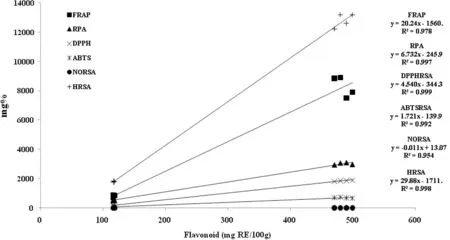
Fig.4.Correlation between flvonoid content and total antioxidant capacity by six different assays of fruit and seed of Rayan.ABTSRSA:ABTS radical scavenging activity;DPPHRSA:DPPH radical scavenging activity;FRAP:ferric reducing antioxidant power assay;HRSA,hydroxyl radical scavenging activity;NORSA,nitric oxide radical scavenging activity;RPA:reducing power assay;GAE,gallic acid equivalent.
Conflict ofinterest
All authors have none to declare.
Acknowledgements
We are grateful to the University Grant Commission(UGC),New Delhi,India for financia support under Major Research Project (F.No.39-96/2010) and for award of UGC BSR fellowship to the firs author (Offic order No.C/2013/8012).Food Testing Laboratory(Department of Biotechnology,Junagadh Agricultural University,Junagadh,Gujarat,India) for analysis of phenolic compounds and Dr.T.V.Ramana Rao(Department of Biosciences,Sardar Patel University,Vallabh Vidyanagar,Gujarat,India)for editing manuscript.
- 食品科学与人类健康(英文)的其它文章
- About the Beijing Academy of Food Sciences
- Toxicological studies of Caesalpinia sappan wood derived dye in Wister albino rats
- Phenolic extract from Ocimum basilicum restores lipid metabolism in Triton WR-1339-induced hyperlipidemic mice and prevents lipoprotein-rich plasma oxidation
- Reversal of acetaminophen-generated oxidative stress and concomitant hepatotoxicity by a phytopharmaceutical product
- GUIDE FOR AUTHORS
- Ketogenic diets and Alzheimer’s disease

